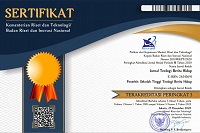Nilai Diri Disabilitas terhadap Dirinya Sendiri dalam Model Disabilitas
DOI:
https://doi.org/10.38189/jtbh.v5i2.372Keywords:
Disability, Disability models, self-worth, RelationalAbstract
The study's objective is to explore the self-value of disability from a disability perspective. The model as an approach to disability studies has been categorically stigmatic. Looking at disability only at the model level, it falls into an understanding that tends to bring disability into categories, victims who deserve to be pitied (Charity model), the sick (medical model), not potential (social model), and stigmatized by negative identification by cultural models. The disability approach descriptively becomes an analytical knife to unravel the existence of disability problems, thus generating a new perspective on seeing disability. The study's results show that other new constructions of disability models that go beyond internal (self-medical) and external (socio-cultural) problems show that disability is not viewed from a negative perspective but from a different point of view. The relational model will bring disability in the I-Thou Buber relation and philosophically-theologically in the perichoresis relation. The relation is built on the principle of trinitarian relations: Father, Son, and Holly Spirit.
References
Andyani, Siska, and Christiana Hari Soetjiningsih. “Hubungan Konsep Diri Dengan Kematangan Karier Pada Remaja Penyandang Disabilitas Daksa.†Jurnal Bimbingan Konseling Indonesia 6, no. 2 (2021): 185–198. https://ejournal2.undiksha.ac.id/index.php/jurnal_bk/article/view/724.
Buber, Martin. “I And Thou.†T & T Clark, 1937.
CBM. Disability Inclusive Development Toolkit, 2017. https://www.cbm.org/fileadmin/user_upload/Publications/CBM-DID-TOOLKIT-accessible.pdf.
Clulee, Evan. “Beyond Charity How Can Society Have a High Value of Disabled People?†In Theology and the Experience of Disability Interdisciplinary Perspectives from Voices Down, edited by Andrew Picard and Myk Habets, 199–211. London - New York: Routledge, 2016.
Creamer, Deborah Beth. Disability and Christian Theology Embodied Limits and Constructive Possibilities. New York: Oxford University Press, 2009.
Darling, Rosalyn Benjamin. Disabiliti and Identityt: Negotiation Self in a Changing Society. UK-USA: Lynne Rienner Publisher, 2013.
Ellis, Katie. Disability and Popular Culture: Focusing Passion, Creating Community and Expressing Defiance. England-USA: Ashgate Publishingg Company, 2015.
Emira, Ezi, and Hasmila Sari. “Konsep Diri Penyandang Disabilitas.†Jurnal Ilmiah Mahasiswa Fakultas Kesehatan 3, no. 3 (2018): 20–29. https://jim.unsyiah.ac.id/FKep/article/view/8280.
Goffman, Erving. Stigma: Notes on the Management of Spoiled Identity. USA: Englewood Cliffs, 1963.
Harisantoso, Imanuel Teguh. “Masker: Pendekatan Konseling Pastoral Di Era Pandemi.†Jurnal Berita Hidup 4, no. 2 (2022): 552–574. https://e-journal.iaidalwa.ac.id/index.php/jbh/article/view/169.
———. “Persepsi Jemaat Tentang Kaum Disabilitas Dan Akses Mereka Ke Dalam Pelayanan Gereja.†Visio Dei: Jurnal Teologi Kristen 4, no. 1 (2022): 58–81. https://jurnal.sttstarslub.ac.id/index.php/js/article/view/242.
Lawson, Wendy. Concepts Of Normality. London and Philadelphia: Jessica Kingsley Publishers, 2008.
Lewis, Hannah. Deaf Liberation Theology. England-USA: Ashgate Publishing Limited, 2007.
Loughnane, Rory. “Introduction: Stages of Normality.†In Staged Normality in Shakespeare’s England, edited by Rory Loughnane and Semple Edel, 1–32. USA: Palgrave mcMillan, 2019.
Marx, Tzvi C. Disability In Jewish Law. London and New York: Routldge, 2002.
McLachlan, David. Accessible Atonement Disability, Theology, and the Cross of Christ. Texas: Baylor University Press, 2021.
McLean, Sheila A.M., and Laura Williamson. Impairment and Disability: Law and Ethics at the Beginning and End of Life. Abingdon: Routledge-Cavendish, 2007.
Mitchell, David T., and Sharon L. Snyder. Narrative Prosthesis Disability and the Dependencies of Discourse. USA: The University of Michigan Press, 2011.
Nazir, M. Metode Penelitian. Jakarta: Ghalia Indonesia, 1985.
Oliver, Michael. Understanding Disability: From Theory to Pactice. USA: Macmillan Education, 1996.
Olyan, Saul M. Disability in the Hebrew Bible. New York: Cambridge University Press, 2008.
Pembroke, Neil. Renewing Pastoral Practice Trinitarian Perspectives on Pastoral Care and Counselling. England-USA: Ashgate Publishing, 2006.
Raphael, Rebecca. Biblica Corpora: Representations of Disability in Hebrew Biblical Literature. New York: T & T Clark International, 2008.
Rapley, Mark. The Social Construction of Intellectual Disability. UK-USA: Cambridge University Press, 2004.
Riyanto, Armada. Relasionaitas Filsafat Fondasi Interpretasi: Aku, Teks, Liyan, Fenomen. Yogyakarta: Penerbit Kanisius, 2018.
Schipper, Jeremy. Disability Studies and the Hebrew Bible: Figuring Mephibosheth in the David Story. New York-London: T & T Clark International, 2006.
Shakespeare, Tom. Disability The Basic. London-New York: Routledge, 2018.
Simanjuntak, Bungaran Antonius, and Rudjito Sosrodihardjo. Metode Penelitian Sosial (Edisi Revisi). Jakarta: Yayasan Pustaka Obor Indonesia, 2009.
Sinulingga, Isabella Novsima. “Disabilitas Sebagaii Objek Ilmu Pengetahuan: Retardasi Mental Dalam Peziarahan Normalisme.†In Dari Disabilitas Ke Penebusan, edited by Ronald Arulangi, Hans Abdiel Harmakaputra, Nindyo Sasongko, and Abraham Silo Wilar, 1–23. Jakarta: BPK Gunung Mulia, 2016.
Smeltzer, S.C. “Improving the Health and Wellness of Persons with Disabilities: A Call to Action Too Importan for Nursing to Ignore.†Nurs Outlock 55 (2007): 189–195. https://nisonger.osu.edu/media/bb_pres/marks_11-12/handouts/Handout 5 - Models of Disability (Smeltzer).pdf.
Snyder, Sharon L., and David T Mitchell. Cultural Locations of Disability. Chicago-London: The University of Chicago Press, 2006.
Wahyuni, Winda, and Anggia K.E Marettih. “Hubungan Citra Tubuh Dengan Identitas Diri Pada Remaja Dengan Disabilitas Fisik.†Jurnal Psikologi 8, no. 1 (2012): 62–66. https://ejournal.uin-suska.ac.id/index.php/psikologi/article/view/184.
WHO. International Classification of Functioning, Disability and Health. India, 2007. https://apps.who.int/iris/bitstream/handle/10665/43737/9789241547321_eng.pdf.
Widinarsih, Dini. “Penyandang Disabilitas Di Indonesia: Perkembangan Istilah Dan Definisi.†Jurnal Ilmu Kesejahteraan Sosial 2, no. 20 (2019): 127–142. http://jurnalkesos.ui.ac.id/index.php/jiks/article/view/239.
Wilson, Shula. Disability, Counselling, and Psychotherapy: Challenges and Opportunities. New York: Palgrave Macmillan, 2003.
“Biopsychosocial Model.†Wikipedia. https://en.wikipedia.org/wiki/Biopsychosocial_model#cite_note-1.
“Conceptual Models of Disability and Functioning.†Pshysicopedia. https://www.physio-pedia.com/Conceptual_Models_of_Disability_and_Functioning.
“Konvensi Internasional Tentang Hak Difabel - CRPD.†Solider: Beranda Inklusi Dan Informasi Difabel. Last modified 2012. Accessed July 25, 2022. https://www.solider.id/baca/592-konvensi-internasional-tentang-hak-difabel-crpd.
Laporan Tahunan HAM, 2012. https://drive.google.com/drive/folders/0BwlNYx1bLggJcXBzbS10SEZ0eUk.
The Biopsychosocial Approach, n.d. https://www.urmc.rochester.edu/medialibraries/urmcmedia/education/md/documents/biopsychosocial-model-approach.pdf.
UU RI No 19 Tahun 2011 Tentang Pengesahan Convention On The Rights of Persons With Disabilities (Konvensi Mengenai Hak-Hak Penyandang Disabilitas), 2011.
UU RI No 8 Tahun 2016 Tentang Penyandang Disabilitas, 2016.


.jpg)







